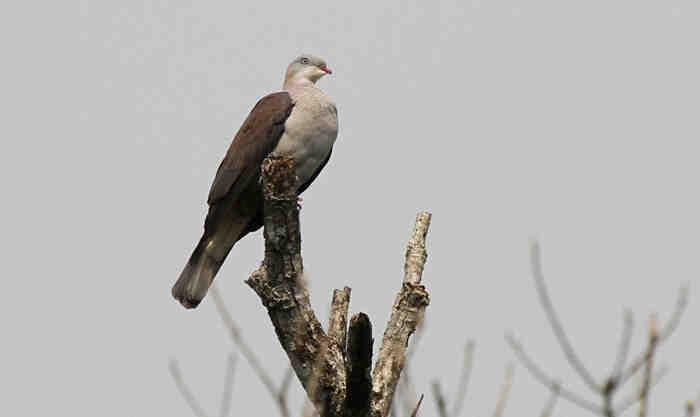Ducula badia
IUCN
LCBasic Information
Scientific classification
- name:Ducula badia
- Scientific Name:Ducula badia ,Mountain Imperial Pigeon,Millet-backed imperial pigeon, Grey-headed southern pigeon
- Outline:Landfowl
- Family:Columbiformes Columbidae L.Pigeon
Vital signs
- length:38.5-47cm
- Weight:380-570g
- lifetime:About 10-15 years
Feature
The call is deep and gives people a sad feeling. It bends and kowtows when calling.
Distribution and Habitat
Distributed in Bhutan, Brunei Darussalam, Cambodia, China, India, Indonesia, Lao People's Democratic Republic, Malaysia, Myanmar, Nepal, Thailand, Vietnam. In China, it is distributed in southwestern and southern Yunnan and Hainan Island.
It mainly inhabits mountain evergreen broad-leaved forests below 2,000 meters above sea level.
Appearance
The forehead, top of the head and sides of the head of the Mountain Emperor Dove are light gray, and the nape and neck are light purple. The small and middle coverts on the shoulders, upper back, and wings are purplish reddish brown or purplish maroon, and the lower back, waist, and upper tail coverts are grayish brown. The tail is dark brown with broad gray-brown end spots. The flight feathers are black, and the inner secondary flight feathers are the same as the back. The large coverts are grayish brown with light chestnut edges. The chin and throat are white, the sides of the head and front neck are gray, the chest and abdomen are light grape gray, the flanks and armpit feathers are gray, and the feathers under the tail are yellow or light brown-white. The iris is off-white, the mouth is orange-red or dark orange-red, the tip is dark brown, and the feet are orange-red or lavender-orange.
Size measurements: body weight ♂450-535g, ♀380-570g; body length ♂390-455mm, ♀385-470mm; bill
Details
Mountain Imperial Pigeon is called Mountain Imperial Pigeon in foreign language, and has 6 subspecies.

Mountain Imperial Pigeon often moves in small groups, and occasionally in large groups of about 40. They often move in the canopy of tall trees in the forest. In the morning and evening, they often roost on the top of the tree to bask in the sun. They fly fast and powerfully, flapping their wings frequently, often making a whirring sound. Especially before the heavy rain, they often fly low in groups and are very active. Their calls are deep, giving people a feeling of sadness, and they bend their waists and kowtow when they call.
The mountain emperor pigeon mainly feeds on plant fruits, especially olives, black olives and Qiongnan fruits.
The breeding season of the mountain emperor pigeon is from April to June. Some begin to lay eggs as early as March to April and as late as August to September. Perhaps some individuals lay two nests a year. They nest on trees in deep mountains and dense forests, and occasionally on trees beside the road. The nest is flat and mainly made of dead branches piled between tree branches. Each nest lays one egg, occasionally two. The egg is white and measures 44-49 mm x 32-36 mm. The male and female birds take turns incubating the eggs.
During the brooding period, pigeons secrete pigeon milk under the action of prolactin (also known as prolactin) secreted by the posterior lobe of the pituitary gland. Pigeon milk is composed of fat particles, emulsified fat chyle and lymph fluid secreted by the proliferating flat epithelium of the bilateral lateral sac lymphatic area of female and male pigeons, that is, the lymphatic area of the crop bed, which is filled with fat particles, emulsified fat chyle and lymph fluid. After the colostrum period, chyle fluid rich in emulsified fat particles is gradually added. The epithelial lymph papilla of the crop bed generally begins to sprout on the 4th to 5th day of the incubation state. The crop bed of male and female pigeons begins to sprout, the blood vessels of the crop bed are congested and thickened, and the lymphatic vessels proliferate. By the 8th to 9th day, the crop epithelium thickens and enters the pre-brooding state. On the 13th day, its thickness and width have doubled. On the 14th-16th day, it can secrete transparent slightly yellow pigeon milk. On the 18th day, the crop can secrete throat milk. However, on the 7th day after the squab hatches, the amount of crop milk secretion begins to decrease, and the secretion stops on the 10th day. It continues to vomit until the chicks are about 2 weeks old, and the crop bed begins to shrink, and the secretion of pigeon milk gradually stops. The semi-finished chyme that is ground by the gizzard and returned from the glandular stomach is gradually mixed into the chyme, and then it becomes a granular feed mixed with water for direct feeding. If the incubated eggs fail to hatch on time, pigeons with good hatching performance can continue to incubate until the 22nd-24th day at most (these are all related to the incubation performance of the pigeon, the hatching season, the feedback of embryonic development information, the frequency of hatching of the fetus, etc. In the cold winter and spring and the brooding period, the incubation period will often be automatically extended, and it is often difficult to persist in the hot and humid days of summer). At this time, the brooding pigeons will automatically stop incubating with the shrinkage of the crop bed.
Listed in the 2013 IUCN Red List of Threatened Species ver3.1 - Least Concern (LC).
Listed in the second level of the China National Key Protected Wildlife List.
Protect wildlife and eliminate game.
Maintaining ecological balance is everyone's responsibility!








